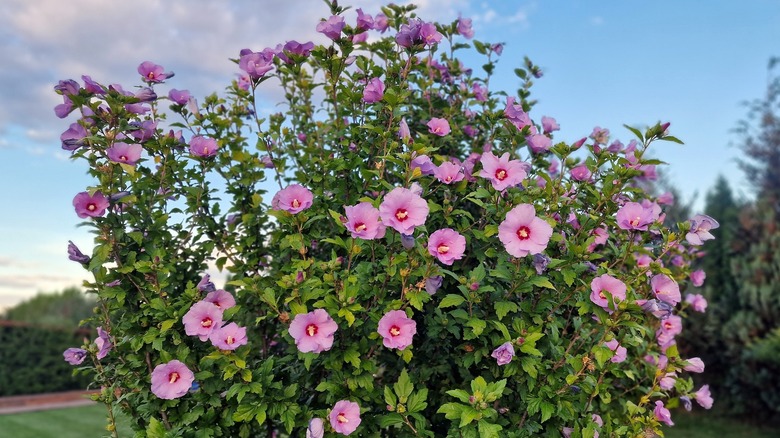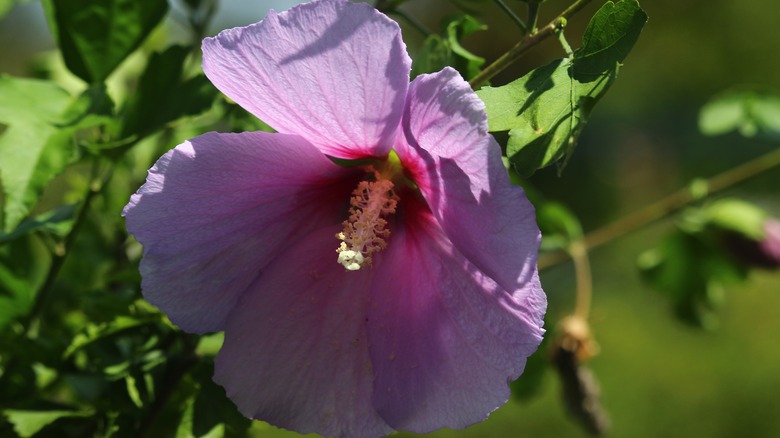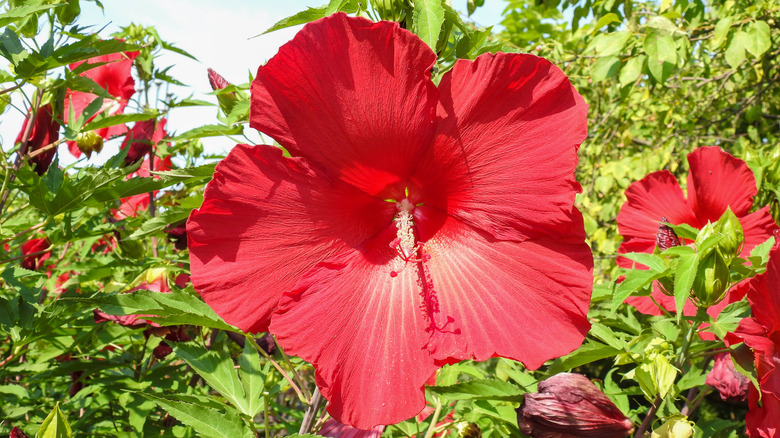Plant These Rose Of Sharon Varieties To Attract Hummingbirds & Avoid A Common Issue
Rose of Sharon (Hibiscus syriacus) shrubs offer massive colorful blooms in late summer through early fall and are a huge hit with hummingbirds, butterflies, and other pollinators. However, it's important to know before planting a rose of Sharon that many cultivars have a nasty habit of dropping seeds everywhere, which can quickly result in your lawn or garden being taken over by little rose of Sharon seedlings. Even worse, in many areas they can spread into natural spaces and become invasive. Fortunately, newer cultivars are available that are partially sterile, allowing you and the pollinators to enjoy this gorgeous flower with fewer fears of invasiveness.
With a mature height of around 12 feet and a width of around 10 feet, even one rose of Sharon shrub (also known as common hibiscus) can easily overwhelm a small space, so the last thing you want is an entire field of them. Thankfully this is where cultivars like 'Helene,' 'Aphrodite,' and 'Minerva' come in. These cultivars were developed in the 1980s, and unlike older varieties, are largely sterile — while still being hardy for zone 5b through zone 9 and offering the toughness, beauty, and pollinator appeal that rose of Sharons are known for.
Nearly sterile rose of Sharon cultivars
With 'Aphrodite' boasting pink flowers, 'Helene' showing off white blossoms, and 'Minerva' having lavender-colored blooms, you don't have to compromise on color to ensure a less invasive plant. These plants, like other rose of Sharon cultivars, flower best in full sun but can also handle shadier locations if necessary. They also have the drought and air pollution tolerance that make rose of Sharons such popular choices for challenging locations.
Unfortunately, even these mostly sterile rose of Sharon varieties are not without drawbacks. A study from Oregon State University found that they can cross with other rose of Sharon cultivars and produce viable seedlings, with 'Aphrodite' particularly prone to this phenomenon. It is therefore essential to keep a close eye on your rose of Sharon shrubs, even those that are supposed to be sterile, to check that they aren't producing offspring.
Removing rose of Sharon shrubs
Heavy pruning or deadheading to remove any seed pods can help keep your rose of Sharon shrubs from producing seedlings. Because rose of Sharon is a shrub that blooms on new wood, you don't have to worry about late pruning preventing you from enjoying flowers the next season. Be sure to check around your shrub for any seedlings that may be growing, as well. Small seedlings should be relatively easy to pull up by hand and larger ones that cannot be manually pulled out can be cut close to ground level. You can also opt to paint the cut with a glyphosate-based herbicide to prevent regrowth. Just be sure to follow all directions on the herbicide label if you take this route.
If watching for seedlings and checking to make sure your shrub is still sterile and not becoming an invasive nuisance isn't for you, then you may want to opt to get a hardy hibiscus type (Hibiscus hybrid) instead. These hybrids of North American native hibiscus plants are hardy in zones 4 through 9 and their massive flowers have earned them the nickname dinner plate hibiscuses. Just like rose of Sharons, hummingbirds, bees, and other pollinators love these shrubs, and they don't have any of the invasive downsides you have to worry about with a rose of Sharon.


